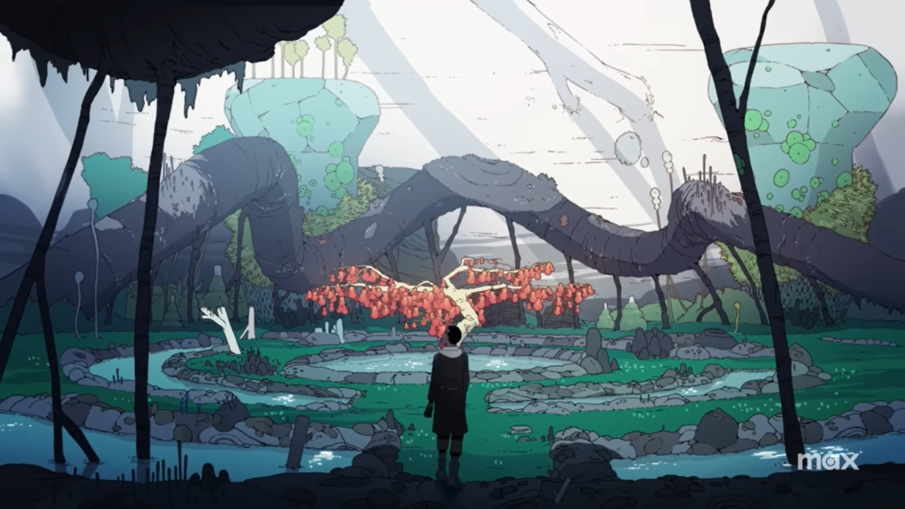Flicking through social media last spring, I accidentally clicked on a video thumbnail sandwiched between posts. I was initially annoyed and moved to swipe away the clip – but within seconds, I was hooked.
What I was watching was the trailer for a then-upcoming animated series called “Scavengers Reign. The first several seconds showed characters emerging from crashed escape pods, stumbling shell-shocked onto the terrain of a new and terrifying world. That plot beat in and of itself isn’t terribly uncommon.
Yet, I couldn’t tear my eyes away. What held my attention was the uniqueness of the world around them. For weeks after, I couldn’t shake memories of how deeply captivated and unsettled I felt upon witnessing the exploding mimic near the end of the trailer. I first waited patiently for the release, and then for a time I could watch it without neglecting schoolwork. Then I binged the entire 12-episode series in under 48 hours.
“Scavengers Reign” follows a rotating cast of main characters, all survivors of a catastrophic breach to space freighter Demeter 227. Their escape pods have brought them to a nearby planet, Vesta Minor, left untouched by human interplanetary colonization.
As many of the pods landed miles apart, the narrative continuously shifts focus between three parties: crewmember Ursula (voiced by Sunita Mani) and captain Sam (voiced by Bob Stephenson); cargo specialist Azi (voiced by Wunmi Mosaku) and assistive robot Levi (voiced by Alia Shawkat); engineer Kamen (voiced by Ted Travelstead) and his mysterious acquired companion.
Those who have not succumbed to despair have their work cut out for them: they must pull the ship out of orbit and onto the planet’s surface, wake any passengers remaining in cryogenic suspension, and restore the functionality of the ship for departure. But trekking to the ship’s landing spot and converging with the other survivors requires that they brave the perils of the natural world.
The episodes of the first season were released in weekly three-episode increments beginning on Oct.19, 2023. and extending through Nove. 9, 2024. The story was initially pioneered by Joe Bennett and Charles Huettner, but the final product credits eight directors, eight producers, and eight writers overall (Bennett and Huettner are credited under all three categories).
Its source material was an eight-minute short film from Bennett and Huettner, titled “Scavengers’, which was released at the end of 2016. Inquisitive readers can find it on both the ShortFilm Window website and YouTube.
The 2023 series was originally distributed on streaming service Max (formerly HBO Max) but was cancelled by the platform on May 10, 2024. This was despite the high praise it received beforehand, including a 100% rating on film review site Rotten Tomatoes.
Within days of Max bringing the axe down, Netflix obtained the streaming rights. A decision has not yet been made whether Netflix will simply showcase the first season or if the show will be un-cancelled and greenlit for further production. Regardless, while the plot appeared to be heading in an intriguing direction at the end of the first season, readers can be assured that it does not leave off on an agonizing cliffhanger.
Standout features of this series are its worldbuilding and character arc progressions. The clean and simple human illustrations contrast sharply with the intricate world around them, riotous with color and texture. Yet, this point is conveyed visually without creating the impression of artistic inconsistency – a delicate balance for the artists to strike.
Likewise, Vesta Minor manages to function as a setting that is alien without being inscrutable. A key component of its visual appeal is that each facet seems designed to nest into an overarching ecological framework. It is not a system that bears much resemblance to that of Earth, but for one critical element: everything rises and falls and cycles through itself again, and again, and again.
And so, it goes for the characters themselves. The process of adjusting to their environment, whether adaptively or maladaptively, parallels the interior journey each one experiences to comprehend what has happened to them.
They approach the daily acts of survival in an unsympathetic world with the same motivations that made them tick within human civilization: Sam as a gruff-but-compassionate leader and provider, Ursula as someone who falls in love with the world through quiet observation, Azi as someone who often absorbs herself in everything but other people, and Kamen as someone who feels constantly misunderstood and desperate to prove himself. Meanwhile, their introspections occur alongside that of Levi. The robot’s time on this planet creates fundamental changes in the way it exists and interacts with the world, constituting an awakening diverging from those of the other leads. Where humans evolve, Levi comes into their own as a being. Where the humans take their pick between methods of symbiosis with the environment, Levi begins to identify as an agent of the natural world.
This is a show I would certainly recommend to viewers who appreciate ecology and/or horror, or who have a keen interest in animation and design. There are a few caveats, though. The emphasis the show places on consumption, referring to both integration of external ideas and to the literal process of sustenance, is quite intense. It does not shy away from graphic depictions of predation, parasitism, and (of course) scavenging. For any readers who might wonder, though, no characters engage in cannibalism. The degree of decomposition displayed at different points in the narrative may deter viewers who are sensitive to viscera. Photosensitive viewers should also be aware that flashing lights are utilized within multiple scenes.
‘Scavengers Reign’ refuses to regurgitate tired survivalist tropes. Not a single character manages to endure the ecosystem of Vesta Minor – though not in the sense that they cannot live. Rather, ‘endure’ in this context refers to the ability of humans to function under the belief that we are not defined by our natural environment.
The cast is not at the mercy of Mother Nature, because such a sentiment implies that they are individuals and equals set apart from her. The development of each character through the story hinges on their realization of this fact and how they come to terms with it.
This world has no infrastructure and no one to help them – only a wide and baffling array of organisms unlike any they’ve encountered before. Nothing familiar is left. The abrupt shift in environment forces them to abandon the extraneous pieces of their perspectives and confront the essence; the only way out is through the belly of the beast.

